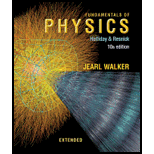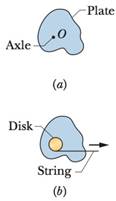
Concept explainers
In Fig. 10-45a, an irregularly shaped plastic plate with uniform thickness and density (mass per unit volume) is to be rotated around an axle that is perpendicular to the plate face and through point O. The rotational inertia of the plate about that axle is measured with the following method, A circular disk of mass 0.500 kg and radius 2.00 cm is glued to the plate, with its center aligned with point O (Fig, 10-45b). A string is wrapped around the edge of the disk the way a string is wrapped around a top. Then the string is pulled for 5.00 s. As a result, the disk and plate are rotated by a constant force of 0.400 N that is applied by the string tangentially to the edge of the disk. The resulting angular speed is 114 rad/s. What is the rotational inertia of the plate about the axle?

Figure 10-45 Problem 55
Want to see the full answer?
Check out a sample textbook solution
Chapter 10 Solutions
Fundamentals of Physics Extended
- 7. Are all scientific theories testable in the commonly understood sense? How does this make you feel? How should you proceed as a scientist or engineer with this understanding?arrow_forwardWhat is an an example of a hypothesis that sounds scientific but is notarrow_forwardWhat is an example of a scientific hypothesisarrow_forward
- Multiverse is called a theory. It has been proposed to account for the apparent and uncanny fine tuning of our own universe. The idea of the multiverse is that there are infinite, distinct universes out there - all with distinct laws of nature and natural constants - and we live in just one of them. Using the accepted definition of the universe being all that there is (matter, space and energy), would you say that multiverse is a scientific theory?arrow_forwardHow is a law usually different than a theoryarrow_forwardA 1.50 mLmL syringe has an inner diameter of 5.00 mmmm, a needle inner diameter of 0.270 mmmm, and a plunger pad diameter (where you place your finger) of 1.2 cmcm. A nurse uses the syringe to inject medicine into a patient whose blood pressure is 140/100. Part A What is the minimum force the nurse needs to apply to the syringe? Express your answer with the appropriate units. View Available Hint(s)for Part A Hint 1for Part A. How to approach the question The force the nurse applies to the syringe can be determined from the fluid pressure and the area of the plunger. The minimum force corresponds to the patient's lowest blood pressure. Use the following equality 760mmofHg=1atm=1.013×10^5Pa760mmofHg=1atm=1.013×10^5Pa.arrow_forward
- A 1.50 mLmL syringe has an inner diameter of 5.00 mmmm, a needle inner diameter of 0.270 mmmm, and a plunger pad diameter (where you place your finger) of 1.2 cmcm. A nurse uses the syringe to inject medicine into a patient whose blood pressure is 140/100. Part A What is the minimum force the nurse needs to apply to the syringe? Express your answer with the appropriate units. View Available Hint(s)for Part A Hint 1for Part A. How to approach the question The force the nurse applies to the syringe can be determined from the fluid pressure and the area of the plunger. The minimum force corresponds to the patient's lowest blood pressure. Use the following equality 760mmofHg=1atm=1.013×10^5Pa760mmofHg=1atm=1.013×10^5Pa.arrow_forwardIs a scientific theory supposed to just be someone's idea about somethingarrow_forwardwhat is the agenda of physicsarrow_forward
 University Physics Volume 1PhysicsISBN:9781938168277Author:William Moebs, Samuel J. Ling, Jeff SannyPublisher:OpenStax - Rice University
University Physics Volume 1PhysicsISBN:9781938168277Author:William Moebs, Samuel J. Ling, Jeff SannyPublisher:OpenStax - Rice University Principles of Physics: A Calculus-Based TextPhysicsISBN:9781133104261Author:Raymond A. Serway, John W. JewettPublisher:Cengage Learning
Principles of Physics: A Calculus-Based TextPhysicsISBN:9781133104261Author:Raymond A. Serway, John W. JewettPublisher:Cengage Learning Physics for Scientists and Engineers: Foundations...PhysicsISBN:9781133939146Author:Katz, Debora M.Publisher:Cengage Learning
Physics for Scientists and Engineers: Foundations...PhysicsISBN:9781133939146Author:Katz, Debora M.Publisher:Cengage Learning Physics for Scientists and Engineers, Technology ...PhysicsISBN:9781305116399Author:Raymond A. Serway, John W. JewettPublisher:Cengage Learning
Physics for Scientists and Engineers, Technology ...PhysicsISBN:9781305116399Author:Raymond A. Serway, John W. JewettPublisher:Cengage Learning Classical Dynamics of Particles and SystemsPhysicsISBN:9780534408961Author:Stephen T. Thornton, Jerry B. MarionPublisher:Cengage Learning
Classical Dynamics of Particles and SystemsPhysicsISBN:9780534408961Author:Stephen T. Thornton, Jerry B. MarionPublisher:Cengage Learning College PhysicsPhysicsISBN:9781305952300Author:Raymond A. Serway, Chris VuillePublisher:Cengage Learning
College PhysicsPhysicsISBN:9781305952300Author:Raymond A. Serway, Chris VuillePublisher:Cengage Learning





